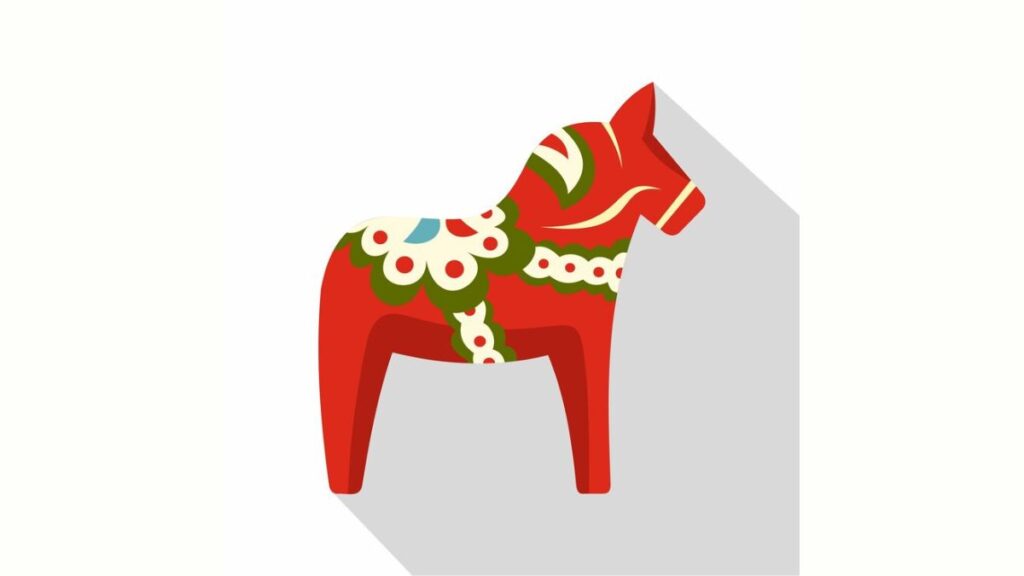Introduction to the Dala Horse
The Dala Horse, or “Dalecarlian Horse,” is one of Sweden’s most cherished cultural symbols. This hand-carved and painted wooden horse has evolved from a simple children’s toy to a powerful emblem of Swedish heritage, craftsmanship, and identity. Recognized around the world, the Dala Horse encapsulates centuries of tradition and artistic expression, rooted deeply in the rural province of Dalarna.
Today, the Dala Horse is more than just a decorative item; it stands for Swedish pride, folklore, and a commitment to traditional handcrafting methods. In this article, we’ll explore the origins, evolution, symbolism, and modern appeal of the Dala Horse while uncovering how it continues to enchant people globally.
Origins and History of the Dala Horse
The story of the Dala Horse dates back several centuries, with its roots firmly planted in the central region of Dalarna. Early versions of the horse were likely carved as toys for children by woodworkers during long Scandinavian winters. These craftspeople, often residing in isolated forest areas, used leftover scraps of pine to create horse figurines — animals that held immense value in agrarian societies.
As the popularity of these toys grew, so did their symbolic significance. By the 17th and 18th centuries, the Dala Horse had become a popular item at markets and local gatherings, where artisans showcased their uniquely painted designs. Initially left unpainted or adorned with simple colors, the horses soon began to feature intricate patterns that reflected regional styles and stories.
Symbolism and Meaning Behind the Dala Horse
More than just a toy, the Dala Hors’e carries deep symbolic value. Horses have historically represented strength, courage, and loyalty — traits held in high regard in Swedish folklore. The Dala Horse, in particular, came to symbolize good luck and protection. It was not uncommon for these horses to be placed in homes as talismans of well-being and fortune.
The specific colors and floral decorations on the horses often represent different regions and cultural narratives. For example, the most iconic version, typically painted in red with kurbits (a kind of decorative floral pattern), originates from the village of Nusnäs. Each stroke of the paintbrush contributes to the horse’s unique character and meaning.
Curious to learn more? Dive into the rest of our blog for helpful tips and insights!
The Art of Making a Dala Horse
Crafting a Dala Hors’e is a meticulous process, handed down through generations. The journey begins with selecting high-quality pinewood, often sourced locally. The wood is then hand-carved into the recognizable horse shape using traditional knives and tools.
Once carved, the horse undergoes a series of sanding and priming stages to ensure a smooth surface. Afterward, it is painted — usually with a base coat of bright red. The final and most intricate step is the hand-painting of decorative patterns, often in hues of white, green, blue, and yellow. These patterns are usually painted freehand by skilled artists, many of whom have spent years mastering the technique.
No two Dala Horses are exactly alike. The handcrafting process ensures that each piece is a work of art, imbued with personal attention and cultural depth.
Dala Horse in Swedish Culture
Throughout Sweden, the Dala Hors’e is celebrated as a national icon. It appears in everything from home décor to official emblems and public artworks. Particularly in Dalarna, you’ll find oversized Dala Horses displayed in town centers, roadside attractions, and museums.
The horse plays a role in traditional festivals and celebrations, often given as a gift to signify goodwill or national pride. During midsummer festivals, tourists and locals alike may see Dala Horse crafting demonstrations, highlighting the enduring appeal of this folk art.
The horse’s symbolism also resonates during times of international representation. For instance, Dala Horses were gifted to foreign dignitaries and featured in exhibitions at world fairs, most notably at the 1939 World’s Fair in New York, where it was introduced as a representation of Sweden’s cultural heritage.
The Global Appeal of the Dala Horse
In modern times, the Dala Hors’e has found admirers far beyond Sweden’s borders. It is a popular souvenir among tourists and is also featured in Swedish-themed events and decor worldwide. Scandinavian design, known for its minimalism and emphasis on nature, often incorporates Dala Horses as a touch of colorful tradition.
The Dala Horse has also become a trendy symbol in design and fashion. You’ll find its likeness on textiles, jewelry, kitchenware, and even tattoos. Its vibrant patterns and nostalgic charm make it an appealing icon for those seeking a connection to Swedish roots or simply appreciating fine craft.
Additionally, the Dala Horse is commonly associated with Christmas and other holiday seasons, where it appears in festive arrangements, holiday cards, and traditional decorations.
Dala Horse as a Collector’s Item
For many, collecting Dala Horses is a cherished hobby. Vintage and antique Dala Horses, especially those made in the early 20th century or earlier, are considered valuable collectibles. The older the horse and the more intricate the craftsmanship, the more desirable it becomes to collectors.
Different villages have historically produced distinct styles of Dala Horses, which adds to the intrigue and variety for collectors. Pieces from villages like Rättvik, Leksand, and Nusnäs each carry unique artistic signatures that differentiate them from one another.
Collectors often look for authenticity marks, such as the signature of the artist or the manufacturer’s stamp. Some of the most reputable producers, like the Nils Olsson factory in Nusnäs, have been creating these horses since the 1920s and are still in operation today.
The Dala Horse Industry Today
Despite industrialization, the art of Dala Horse-making remains predominantly manual and localized. The industry thrives primarily in Nusnäs, where workshops continue to attract thousands of visitors each year. Tourists can watch artisans at work, purchase customized horses, and even try their hand at painting their own.
While mass-produced imitations exist, the demand for authentic, handmade Dala Horses remains strong. These original pieces are celebrated for their quality, heritage, and the story they tell about Swedish culture.
Additionally, the Dala Horse industry contributes to regional economic development, sustaining small businesses and craftspeople while promoting tourism in Dalarna.
Incorporating Dala Horses in Modern Design
Designers and interior decorators frequently turn to the Dala Horse for inspiration. Its bold silhouette and colorful patterns serve as striking accents in both traditional and contemporary spaces.
In Scandinavian-themed interiors, Dala Horses can be displayed on shelves, mantels, or even used as centerpieces. Minimalist designs often benefit from the burst of color and whimsy that these horses provide. Many people use them as a way to celebrate their heritage or add a personal, artisanal touch to their living spaces.
Moreover, Dala Horses have found their way into graphic design and digital art. Logos, branding materials, and marketing content sometimes incorporate the horse to symbolize reliability, creativity, and cultural authenticity.
Ready to take things further? Discover our full library of content.
Teaching Cultural Values Through the Dala Horse
The Dala Horse is also a valuable educational tool. In schools and cultural centers, it serves as an entry point to discussions about Swedish history, folklore, and traditional crafts.
Children and adults alike enjoy learning about the horse’s origins and even creating their own versions in workshops. These activities foster appreciation for handcrafts, creativity, and cultural diversity. The horse becomes a medium through which values such as patience, precision, and cultural preservation are taught.
Conclusion
The Dala Horse is far more than a quaint wooden toy. It is a vibrant emblem of Sweden’s soul — representing resilience, tradition, and the timeless beauty of handcraftsmanship. From its humble origins in the forests of Dalarna to its place in global pop culture, the Dala Horse continues to capture hearts with its charm and authenticity.
Whether cherished as a family heirloom, collected as a piece of folk art, or used to infuse homes with Scandinavian warmth, the Dala Horse stands as a proud testament to the enduring legacy of Swedish culture.
FAQs
What is a Dala Horse?
A Dala Horse is a traditional Swedish wooden horse figure, typically hand-carved and painted, originating from the Dalarna region.
Why is the Dala Horse red?
The red color is traditional and symbolizes happiness and good luck. It also makes the decorative patterns stand out vividly.
Where can I buy an authentic Dala Horse?
Authentic Dala Horses can be purchased in Sweden, particularly in Dalarna, or through reputable online retailers like the Nils Olsson and Grannas A. Olsson workshops.
Are Dala Horses still handmade?
Yes, many Dala Horses are still handmade using traditional methods in Sweden, especially in the village of Nusnäs.
What does the Dala Horse symbolize?
The Dala Horse symbolizes strength, courage, loyalty, and Swedish heritage. It’s often seen as a good luck charm or cultural keepsake.







